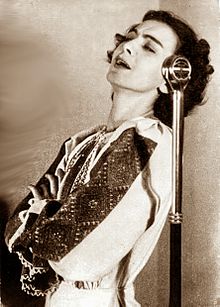Maria Tănase
| Maria Tănase | |
|---|---|
 |
|
| Born | 25 September 1913 Bucharest, Romania |
| Died | 22 June 1963 (aged 49) Bucharest, Romania |
| Nationality | Romanian |
| Occupation | Singer, actress |
| Years active | 1935–1963 |
| Spouse(s) | Clery Sachelarie (m. 1950–63) (her death) |
Maria Tănase (Romanian pronunciation: [maˈri.a təˈnase]; 25 September 1913 – 22 June 1963) was a Romanian singer and actress. Her music ranged from traditional Romanian music to romance, tango, chanson and operetta.
Tănase has a similar importance in Romania to that of Édith Piaf in France or Amália Rodrigues in Portugal. In her nearly three-decade-long career, she became widely regarded as Romania's national diva, being admired for her originality, voice, physical beauty and charisma. In Romania, she is still regarded as a major cultural icon of the 20th century. In 2006 she was included to the list of the 100 Greatest Romanians of all time by a nation-wide poll.
Among her songs are Cine iubește și lasă (1937), Leliță cârciumăreasă (1939), Bun îi vinul ghiurghiuliu (1938), Doina din Maramureş (1956), Ciuleandra (1956) and Până când nu te iubeam.
Born in Bucharest suburb of Cărămidarii de Jos, or Cărămidari, Maria Tănase attended Primary School number 11 from Tăbăcari. Her father, Ion Coanda Tănase, was a master gardener and a florist, also owner of a big nursery on the outskirts of Bucharest, which employed female workers from different various regions of Romania. These women, in turn, would share traditional folk songs and tales which deeply enthralled little Maria, which was to leave a permanent mark on her.
She made her stage debut in Cărămidarii de Jos, at the "Ion Heliade Rădulescu" High School. In 1934, she joined the "Cărăbuş" Theatre of Constantin Tănase with the help and advice of newspaper writer Sandu Eliad, who, at that time was her partner. Her real debut took place on 2 June 1934 with the stage name Mary Atanasiu. In the fall of 1937 she recorded her first folk songs at the Columbia studio in Bucharest. On 20 February 1938 her voice was heard for the first time on the radio. Shortly after, she started to develop a local and international following. She represented Romania at the 1939 New York World's Fair. During the first months of the National Legionary State, Maria Tănase was banned from performing in public and her recordings were destroyed.
...
Wikipedia
